Home / The Strecker Synthesis of Amino Acids
Amines
The Strecker Synthesis of Amino Acids
Last updated: February 9th, 2023 |
The Strecker Amino Acid Synthesis
- The Strecker synthesis is a two-step procedure for the synthesis of amino acids.
- It begins with the addition of cyanide ion to an imine, forming an alpha-amino nitrile. This is then hydrolyzed (e.g. with strong acid) to give an alpha-amino acid.
- By varying the R group on the imine, a wide variety of amino acids may be made this way.
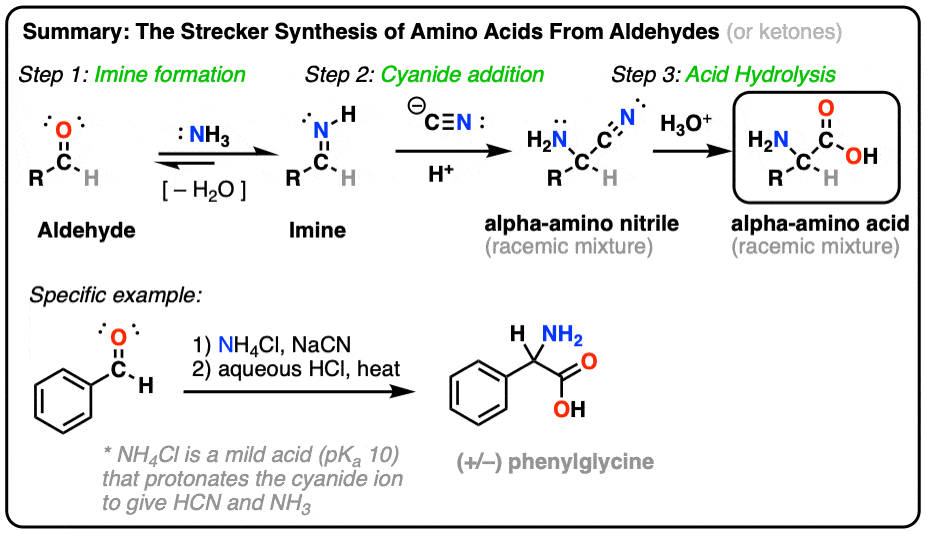
Table of Contents
- The Strecker Synthesis of Amino Acids
- The Two-Part Mechanism of Amino Acids
- Application: Synthesis of L-DOPA
- Notes
- (Advanced) References and Further Reading
1. The Strecker Synthesis of Amino Acids
What’s not to love about the cyanide ion?
OK, OK, it’s a deadly poison, and should be treated extremely carefully in the lab.
But besides that, it’s an excellent nucleophile that can react with a wide variety of electrophiles, resulting in a new carbon-carbon bond terminating in a functional group (nitrile) that can be elaborated in many different ways.
Below are three examples of the cyanide ion in action. When added to alkyl halides, it provides nitriles. It attacks ketones and aldehydes, giving cyanohydrins. And it also attacks the nitrogenous cousins of aldehydes and ketones, otherwise known as imines. This results in alpha-amino nitriles.
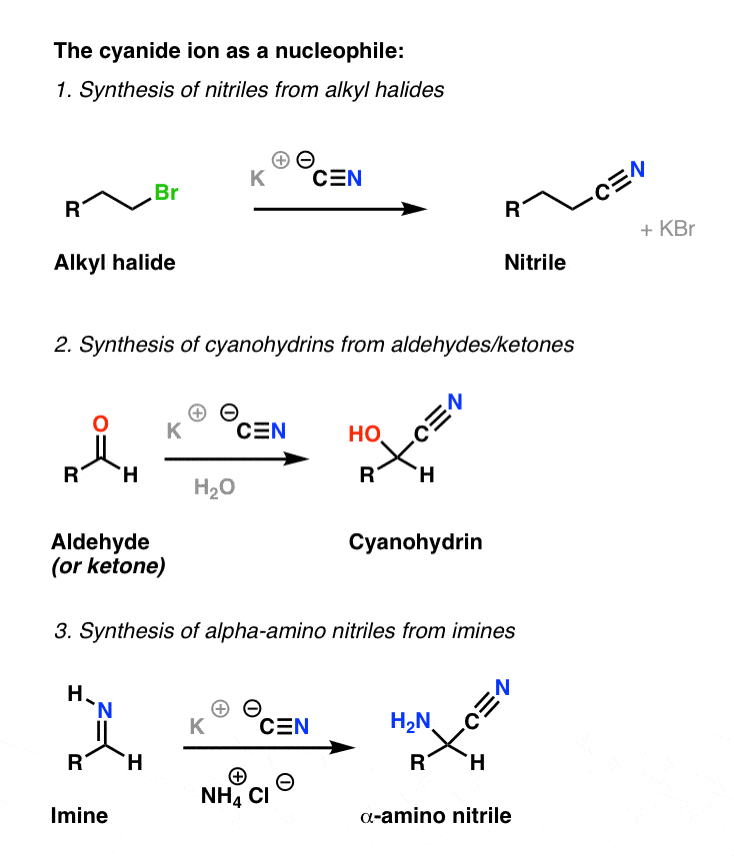
Now, perhaps “alpha amino nitriles” is not a name that easily rolls of the tongue.
But maybe you’ve heard of… amino acids?
As we said, nitriles can be transformed into a wide variety of species: amines (through reduction) ketones (through addition of a Grignard followed by hydrolysis), and most importantly for our purposes, carboxylic acids (through acidic hydrolysis). (See post: Hydrolysis of Amides)
So hydrolysis of an “alpha-amino nitrile” with aqueous acid should be expected to give an alpha-amino acid (or just “amino acid”, for short).
And indeed it does!
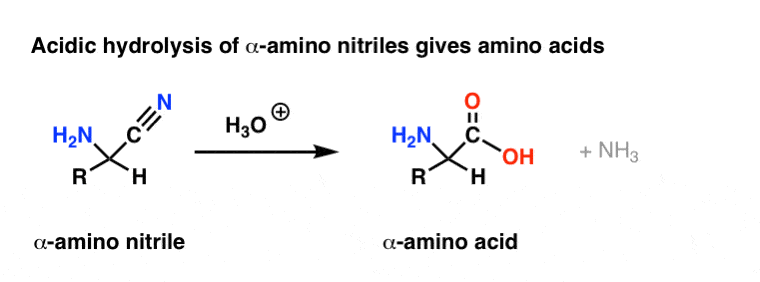
The procedure for making amino acids from aldehydes and ketones (via imines) is known as the Strecker Synthesis of amino acids.
Depending on the “R” group of the imine, a wide variety of amino acids can be synthesized using this method.
For example, here’s a synthesis of phenylalanine, one of the 20 “proteinogenic” (i.e. protein-making) amino acids coded in messenger RNA (mRNA):
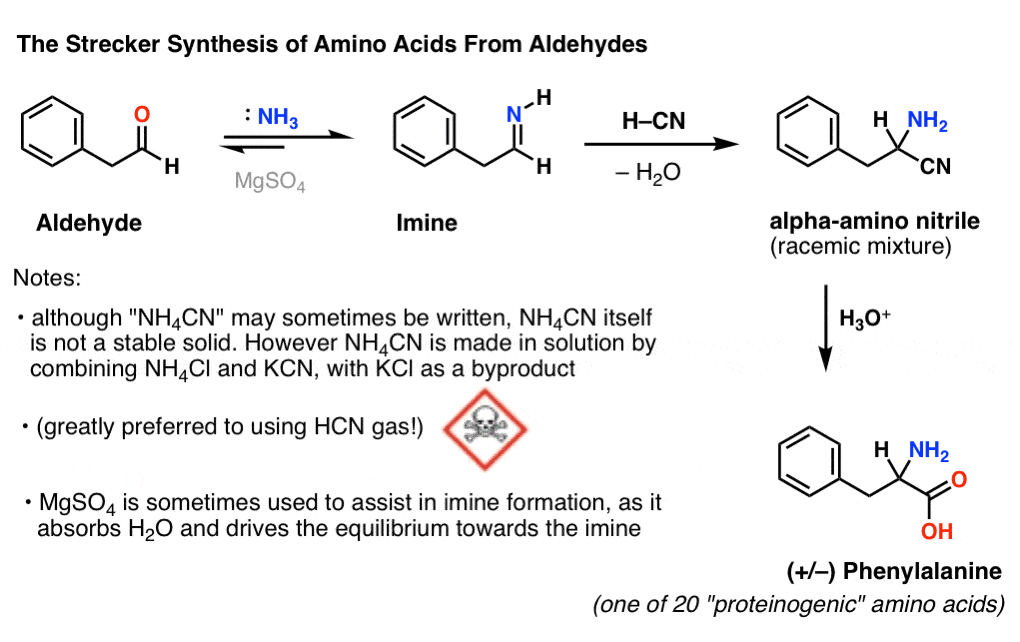
The original Strecker protocol (1850) employed NH3 and hydrogen cyanide (HCN).
Given that most chemists are less than enthusiastic about working with cyanide gas, [Note 1] a safer protocol utilizing the easily-handled solids NH4Cl (ammonium chloride) and KCN (potassium cyanide) is generally employed [Note 2 about NH4CN]. The idea here is that mildly acidic (pKa 9) ammonium ion protonates the aldehyde, activating it towards attack with liberated NH3. After attack of NH3, proton transfer, and elimination of water, the cyanide ion then attacks the resultant imine (or, more likely, the conjugate acid of the imine, known as the “iminium”). This results in the alpha amino nitrile.
Addition of a water-absorbing salt (dessicant) such as MgSO4 often helps with formation of the imine, as it helps drive the equilibrium toward the imine.
2. The Two-Part Mechanism Of The Strecker Synthesis
The first part of the Strecker involves the formation of the alpha-amino nitrile, en route to the proteinogenic amino acid valine (commonly abbreviated as Val or V).
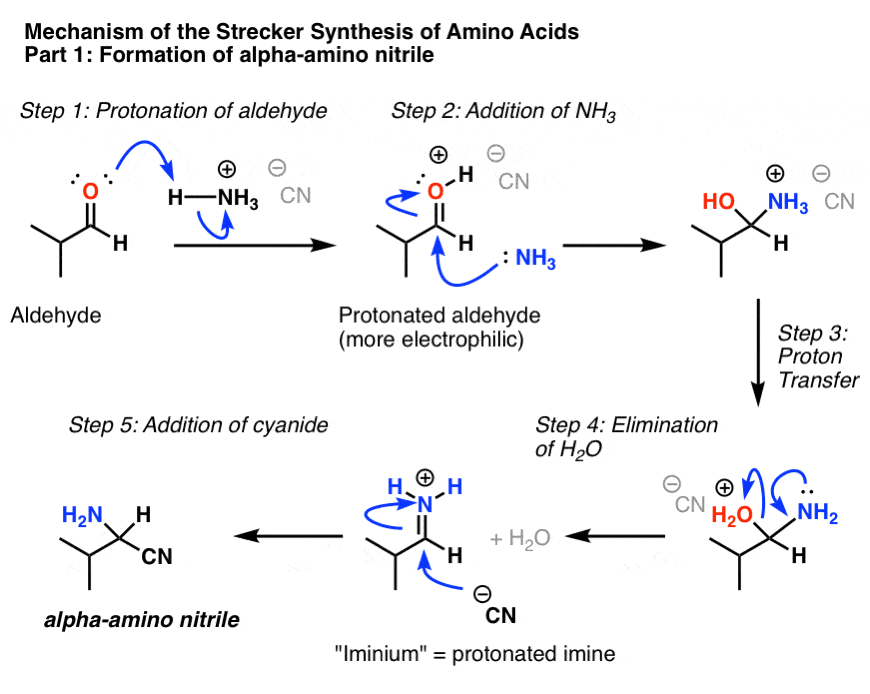
The next step is hydrolysis of the nitrile with aqueous acid. Here it’s depicted as H3O+ with the counterion unspecified as X.
Protonation of the nitrile (note: the NH2 will be protonated as well under these conditions, but for clarity, it’s depicted as the neutral species) is followed by attack of water (step 2). Proton transfer to nitrogen (step 3) followed by addition of water to the carbon (step 4), and another proton transfer to nitrogen (step 5) results in a positively charged ammonium, which is eliminated (step 6) as NH3. Deprotonation of the carbonyl oxygen (step 7) completes the process, giving valine as a racemic mixture of enantiomers.
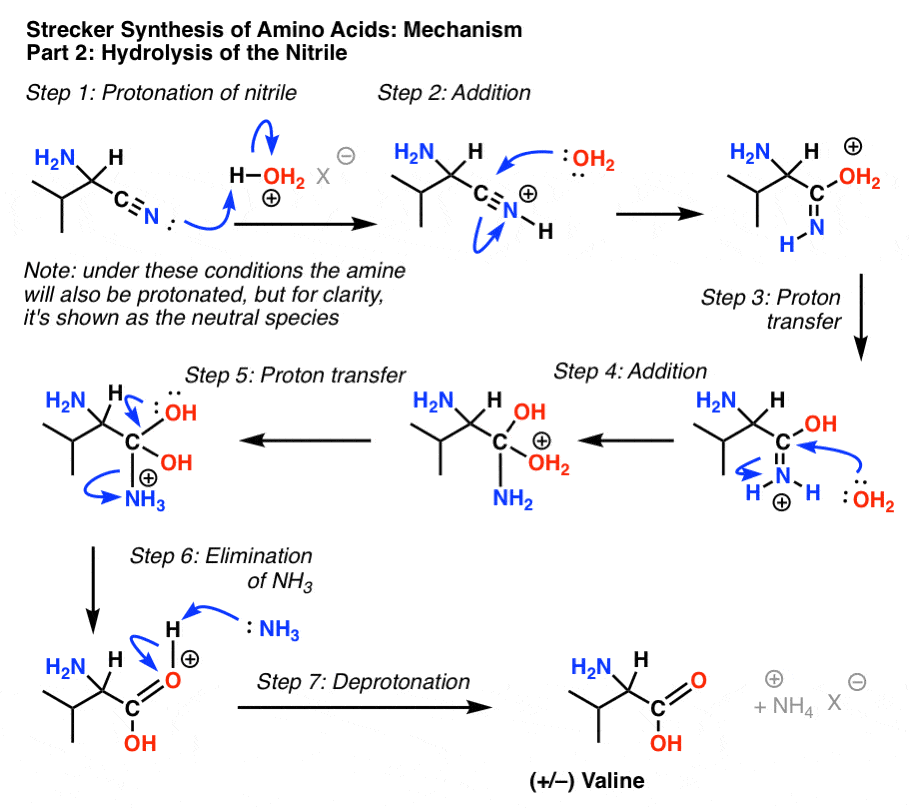
3. Synthesis of a Non-Proteinogenic Amino Acid: L-DOPA
You may ask: so what?
Proteins (e.g. from soy or whey) are readily available, and natural amino acids can be cheaply and easily isolated from hydrolysis of proteins. Since Nature provides them in such abundant supply, why bother making them?
Many reasons. Here’s one: the proteinogenic amino acids are often modified in various ways in vivo, and a method for accessing some of these rarer, modified amino acids becomes necessary. One example is L-DOPA, an important treatment for Parkinson’s disease (in the body it is transformed to dopamine and adrenaline).
In vivo, L-DOPA is made by hydroxylation of tyrosine, but organic chemists haven’t quite mastered how to perform that reaction in the lab just yet. An alternative is to build up L-DOPA through a Strecker reaction. Starting with 3,4-dihydroxyphenylacetaldehyde (below) treatment with “NH4CN” (made from combining NH4Cl and KCN in solution) followed by acidic hydrolysis leads to a racemic mixture of L- and D- DOPA. Pure L-DOPA could then be obtained through a chiral resolution. (Note that DL-DOPA is the same as (+/–)-DOPA. Just a different way of depicting a racemic mixture.) [Note 3]
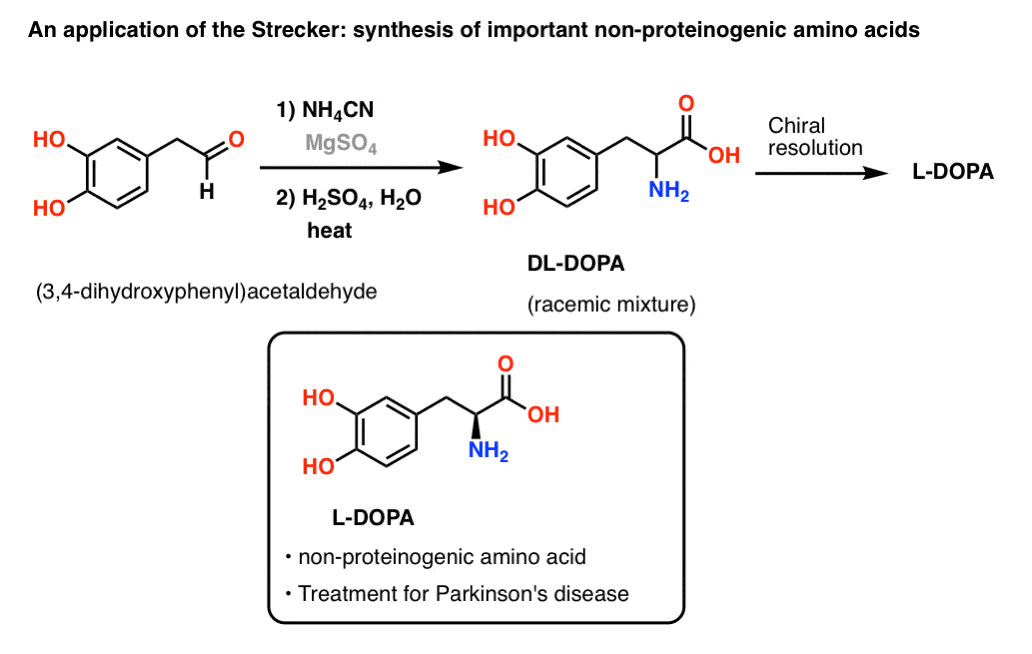
The Strecker can also be applied to build non-natural amino acids having unnatural stereochemistry, fluorescent tags, azides (for “click” chemistry applications), and many other properties. This is not a “fringe” reaction. The Strecker is important.
One caveat: as shown, the Strecker provides racemic amino acids and Nature employs enantiomerically pure amino acids.
So can the Strecker be modified so that it only produces predominantly one enantiomer?
The short answer is yes. One of the first applications of a chiral auxiliary (1963!) was in the Strecker reaction by the group of Harada. In the past few years, various catalytic asymmetric approaches have been developed, which are beyond the scope of our discussion. I refer you to the work of Jacobsen and Song for further reading.
Ironically the problem of making enantiomerically pure L-DOPA was solved not through the Strecker, but through catalytic hydrogenation, developed by Knowles and his group at DuPont in the 1970s. This won a share of the 2001 Nobel Prize for Chemistry, for asymmetric catalysis.
Notes
Related Articles
- Introduction to Peptide Synthesis
- Nucleophilic Addition To Carbonyls
- Amide Hydrolysis
- Hydrolysis of nitriles with aqueous acid to give carboxylic acids (MOC Reaction Guide)
- The Gabriel Synthesis
- Imines – Properties, Formation, Reactions, and Mechanisms
- Strecker Synthesis (MOC Reaction Guide)
- Isoelectric Points of Amino Acids (and How To Calculate Them)
Note 1. This 1941 paper recommends smoking in the lab ( a common enough habit in days of yore) when working with HCN, as it gives cigarette smoke a characteristic taste.
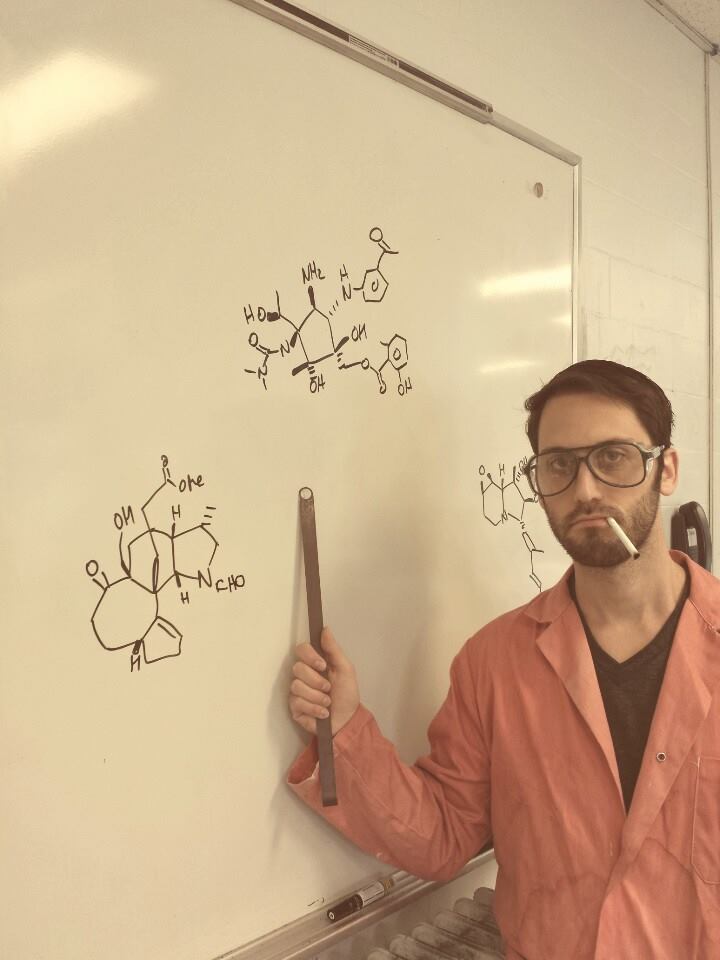
Note 2. Instead of using NH4Cl and KCN, it might seem more efficient to use NH4CN. Alas, NH4CN is not a stable solid, and has the unfortunate property of giving off HCN gas. The solution to this is to make it in situ with NH4Cl and KCN.
Note 3. If you’ve covered carbohydrate chemistry, you might recognize that the Strecker is a close cousin of the Kiliani-Fischer method for chain extension of sugars. It’s the same idea!
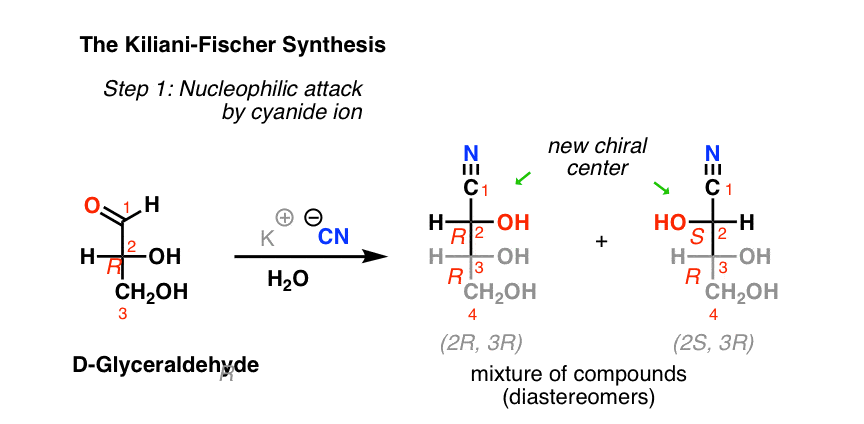
Real Life Examples
Real-Life Examples:
Org. Synth. 1942, 22, 23
DOI Link: 10.15227/orgsyn.022.0023
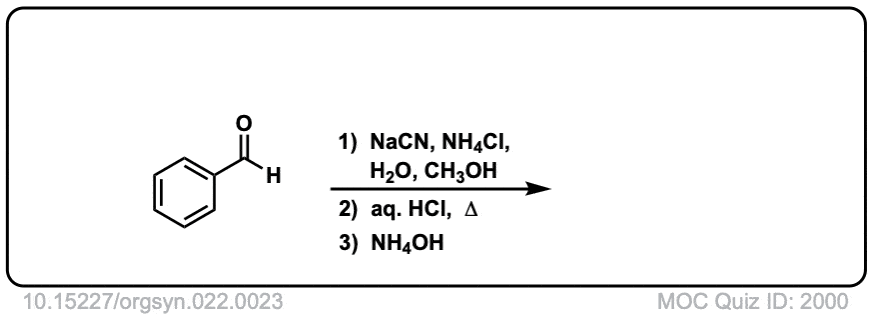 Click to Flip
Click to Flip
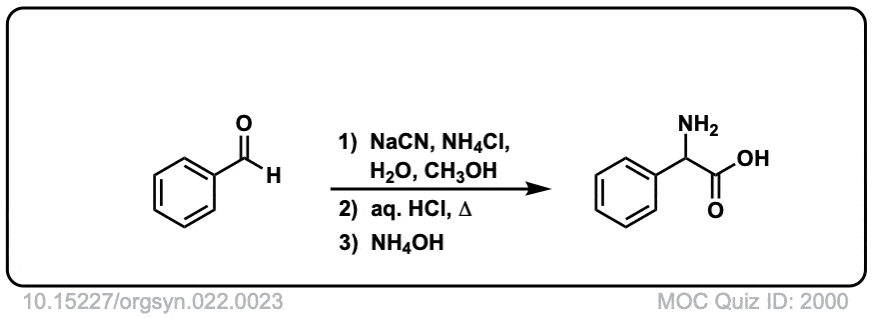
Org. Synth. 1944, 24, 9
DOI Link: 10.15227/orgsyn.024.0009
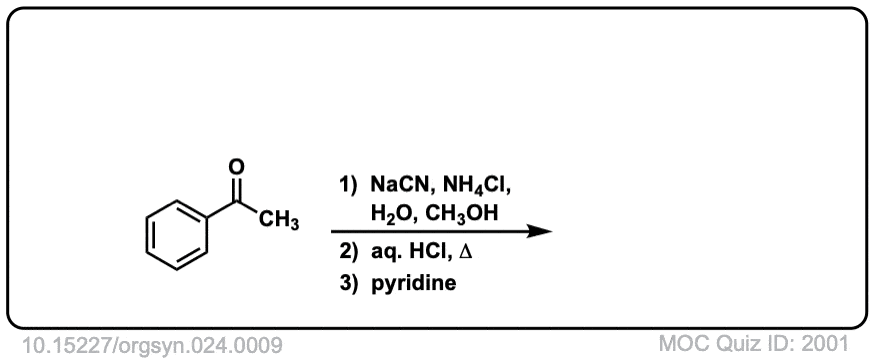 Click to Flip
Click to Flip
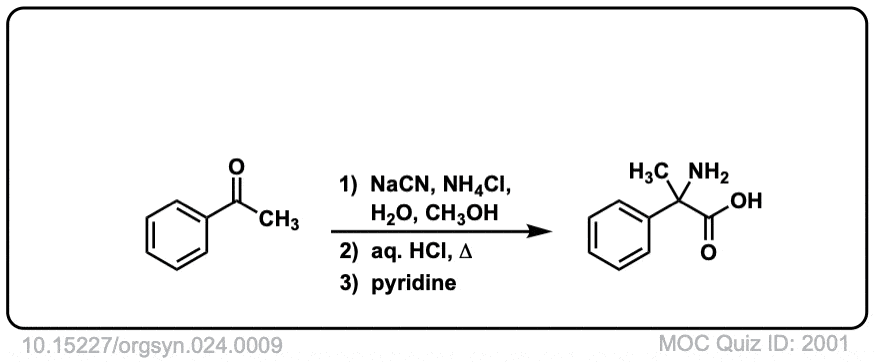
Org. Synth. 1953, 33, 7
DOI Link: 10.15227/orgsyn.033.0007
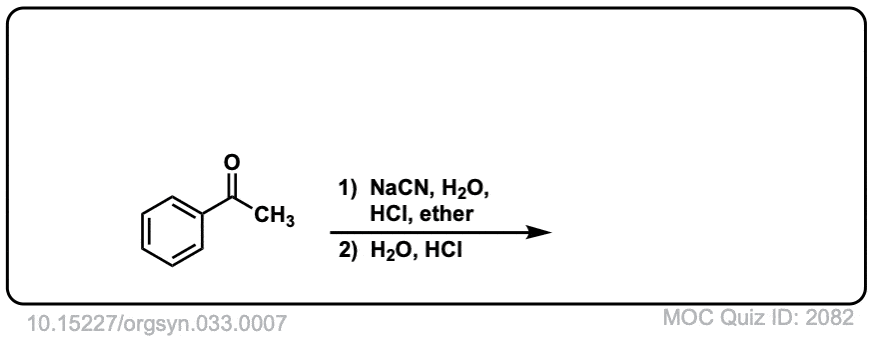 Click to Flip
Click to Flip
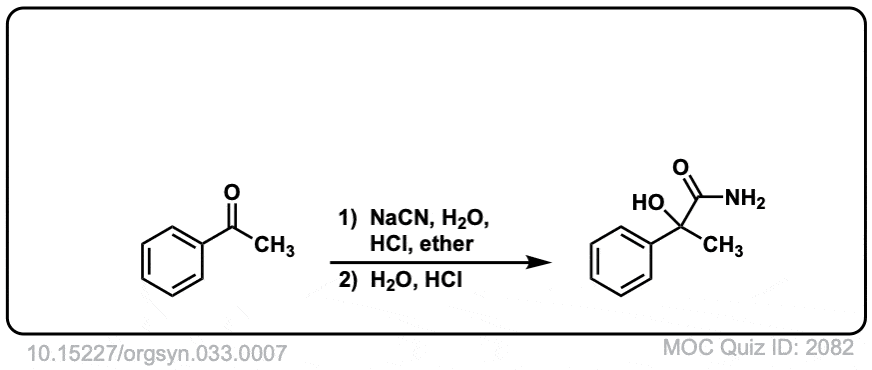
(Advanced) References and Further Reading
This is a very simple but powerful reaction, which takes three components: an aldehyde/ketone, cyanide, and an amine. The product is an a-aminonitrile, which can be hydrolyzed to amino acids.
- Ueber die künstliche Bildung der Milchsäure und einen neuen, dem Glycocoll homologen Körper
Adolf Strecker
Just. Lieb. Ann. Chem. 1850, 75 (1), 27-45
DOI: 10.1002/jlac.18500750103
I think this is the original paper on the Strecker reaction (unfortunately I can’t read German). But it is over 150 years old, indicating that this reaction is really simple and robust. - dl-ALANINE
C. Kendall and B. F. McKenzie
Org. Synth. 1929, 9, 4
DOI: 10.15227/orgsyn.009.0004
An old but reproducible procedure for racemic alanine through a Strecker synthesis. - Enantioselective Catalytic Addition of HCN to Ketoimines. Catalytic Synthesis of Quaternary Amino Acids
Petr Vachal and and Eric N. Jacobsen
Organic Letters 2000, 2 (6), 867-870
DOI: 10.1021/ol005636+
Asymmetric Strecker reaction. Note that this uses HCN as the cyanide source, which is thankfully not used neat or as a gas, but is generated in solution prior to the reaction from TMSCN + methanol (see note 10).
00 General Chemistry Review
01 Bonding, Structure, and Resonance
- How Do We Know Methane (CH4) Is Tetrahedral?
- Hybrid Orbitals and Hybridization
- How To Determine Hybridization: A Shortcut
- Orbital Hybridization And Bond Strengths
- Sigma bonds come in six varieties: Pi bonds come in one
- A Key Skill: How to Calculate Formal Charge
- The Four Intermolecular Forces and How They Affect Boiling Points
- 3 Trends That Affect Boiling Points
- How To Use Electronegativity To Determine Electron Density (and why NOT to trust formal charge)
- Introduction to Resonance
- How To Use Curved Arrows To Interchange Resonance Forms
- Evaluating Resonance Forms (1) - The Rule of Least Charges
- How To Find The Best Resonance Structure By Applying Electronegativity
- Evaluating Resonance Structures With Negative Charges
- Evaluating Resonance Structures With Positive Charge
- Exploring Resonance: Pi-Donation
- Exploring Resonance: Pi-acceptors
- In Summary: Evaluating Resonance Structures
- Drawing Resonance Structures: 3 Common Mistakes To Avoid
- How to apply electronegativity and resonance to understand reactivity
- Bond Hybridization Practice
- Structure and Bonding Practice Quizzes
- Resonance Structures Practice
02 Acid Base Reactions
- Introduction to Acid-Base Reactions
- Acid Base Reactions In Organic Chemistry
- The Stronger The Acid, The Weaker The Conjugate Base
- Walkthrough of Acid-Base Reactions (3) - Acidity Trends
- Five Key Factors That Influence Acidity
- Acid-Base Reactions: Introducing Ka and pKa
- How to Use a pKa Table
- The pKa Table Is Your Friend
- A Handy Rule of Thumb for Acid-Base Reactions
- Acid Base Reactions Are Fast
- pKa Values Span 60 Orders Of Magnitude
- How Protonation and Deprotonation Affect Reactivity
- Acid Base Practice Problems
03 Alkanes and Nomenclature
- Meet the (Most Important) Functional Groups
- Condensed Formulas: Deciphering What the Brackets Mean
- Hidden Hydrogens, Hidden Lone Pairs, Hidden Counterions
- Don't Be Futyl, Learn The Butyls
- Primary, Secondary, Tertiary, Quaternary In Organic Chemistry
- Branching, and Its Affect On Melting and Boiling Points
- The Many, Many Ways of Drawing Butane
- Wedge And Dash Convention For Tetrahedral Carbon
- Common Mistakes in Organic Chemistry: Pentavalent Carbon
- Table of Functional Group Priorities for Nomenclature
- Summary Sheet - Alkane Nomenclature
- Organic Chemistry IUPAC Nomenclature Demystified With A Simple Puzzle Piece Approach
- Boiling Point Quizzes
- Organic Chemistry Nomenclature Quizzes
04 Conformations and Cycloalkanes
- Staggered vs Eclipsed Conformations of Ethane
- Conformational Isomers of Propane
- Newman Projection of Butane (and Gauche Conformation)
- Introduction to Cycloalkanes
- Geometric Isomers In Small Rings: Cis And Trans Cycloalkanes
- Calculation of Ring Strain In Cycloalkanes
- Cycloalkanes - Ring Strain In Cyclopropane And Cyclobutane
- Cyclohexane Conformations
- Cyclohexane Chair Conformation: An Aerial Tour
- How To Draw The Cyclohexane Chair Conformation
- The Cyclohexane Chair Flip
- The Cyclohexane Chair Flip - Energy Diagram
- Substituted Cyclohexanes - Axial vs Equatorial
- Ranking The Bulkiness Of Substituents On Cyclohexanes: "A-Values"
- Cyclohexane Chair Conformation Stability: Which One Is Lower Energy?
- Fused Rings - Cis-Decalin and Trans-Decalin
- Naming Bicyclic Compounds - Fused, Bridged, and Spiro
- Bredt's Rule (And Summary of Cycloalkanes)
- Newman Projection Practice
- Cycloalkanes Practice Problems
05 A Primer On Organic Reactions
- The Most Important Question To Ask When Learning a New Reaction
- Curved Arrows (for reactions)
- Nucleophiles and Electrophiles
- The Three Classes of Nucleophiles
- Nucleophilicity vs. Basicity
- What Makes A Good Nucleophile?
- What Makes A Good Leaving Group?
- 3 Factors That Stabilize Carbocations
- Equilibrium and Energy Relationships
- 7 Factors that stabilize negative charge in organic chemistry
- 7 Factors That Stabilize Positive Charge in Organic Chemistry
- What's a Transition State?
- Hammond's Postulate
- Learning Organic Chemistry Reactions: A Checklist (PDF)
- Introduction to Oxidative Cleavage Reactions
06 Free Radical Reactions
- Bond Dissociation Energies = Homolytic Cleavage
- Free Radical Reactions
- 3 Factors That Stabilize Free Radicals
- What Factors Destabilize Free Radicals?
- Bond Strengths And Radical Stability
- Free Radical Initiation: Why Is "Light" Or "Heat" Required?
- Initiation, Propagation, Termination
- Monochlorination Products Of Propane, Pentane, And Other Alkanes
- Selectivity In Free Radical Reactions
- Selectivity in Free Radical Reactions: Bromination vs. Chlorination
- Halogenation At Tiffany's
- Allylic Bromination
- Bonus Topic: Allylic Rearrangements
- In Summary: Free Radicals
- Synthesis (2) - Reactions of Alkanes
- Free Radicals Practice Quizzes
07 Stereochemistry and Chirality
- Types of Isomers: Constitutional Isomers, Stereoisomers, Enantiomers, and Diastereomers
- How To Draw The Enantiomer Of A Chiral Molecule
- How To Draw A Bond Rotation
- Introduction to Assigning (R) and (S): The Cahn-Ingold-Prelog Rules
- Assigning Cahn-Ingold-Prelog (CIP) Priorities (2) - The Method of Dots
- Enantiomers vs Diastereomers vs The Same? Two Methods For Solving Problems
- Assigning R/S To Newman Projections (And Converting Newman To Line Diagrams)
- How To Determine R and S Configurations On A Fischer Projection
- The Meso Trap
- Optical Rotation, Optical Activity, and Specific Rotation
- Optical Purity and Enantiomeric Excess
- What's a Racemic Mixture?
- Chiral Allenes And Chiral Axes
- Stereochemistry Practice Problems and Quizzes
08 Substitution Reactions
- Nucleophilic Substitution Reactions - Introduction
- Two Types of Nucleophilic Substitution Reactions
- The SN2 Mechanism
- Why the SN2 Reaction Is Powerful
- The SN1 Mechanism
- The Conjugate Acid Is A Better Leaving Group
- Comparing the SN1 and SN2 Reactions
- Polar Protic? Polar Aprotic? Nonpolar? All About Solvents
- Steric Hindrance is Like a Fat Goalie
- Common Blind Spot: Intramolecular Reactions
- Substitution Practice - SN1
- Substitution Practice - SN2
09 Elimination Reactions
- Elimination Reactions (1): Introduction And The Key Pattern
- Elimination Reactions (2): The Zaitsev Rule
- Elimination Reactions Are Favored By Heat
- Two Elimination Reaction Patterns
- The E1 Reaction
- The E2 Mechanism
- E1 vs E2: Comparing the E1 and E2 Reactions
- Antiperiplanar Relationships: The E2 Reaction and Cyclohexane Rings
- Bulky Bases in Elimination Reactions
- Comparing the E1 vs SN1 Reactions
- Elimination (E1) Reactions With Rearrangements
- E1cB - Elimination (Unimolecular) Conjugate Base
- Elimination (E1) Practice Problems And Solutions
- Elimination (E2) Practice Problems and Solutions
10 Rearrangements
11 SN1/SN2/E1/E2 Decision
- Identifying Where Substitution and Elimination Reactions Happen
- Deciding SN1/SN2/E1/E2 (1) - The Substrate
- Deciding SN1/SN2/E1/E2 (2) - The Nucleophile/Base
- SN1 vs E1 and SN2 vs E2 : The Temperature
- Deciding SN1/SN2/E1/E2 - The Solvent
- Wrapup: The Key Factors For Determining SN1/SN2/E1/E2
- Alkyl Halide Reaction Map And Summary
- SN1 SN2 E1 E2 Practice Problems
12 Alkene Reactions
- E and Z Notation For Alkenes (+ Cis/Trans)
- Alkene Stability
- Alkene Addition Reactions: "Regioselectivity" and "Stereoselectivity" (Syn/Anti)
- Stereoselective and Stereospecific Reactions
- Hydrohalogenation of Alkenes and Markovnikov's Rule
- Hydration of Alkenes With Aqueous Acid
- Rearrangements in Alkene Addition Reactions
- Halogenation of Alkenes and Halohydrin Formation
- Oxymercuration Demercuration of Alkenes
- Hydroboration Oxidation of Alkenes
- m-CPBA (meta-chloroperoxybenzoic acid)
- OsO4 (Osmium Tetroxide) for Dihydroxylation of Alkenes
- Palladium on Carbon (Pd/C) for Catalytic Hydrogenation of Alkenes
- Cyclopropanation of Alkenes
- A Fourth Alkene Addition Pattern - Free Radical Addition
- Alkene Reactions: Ozonolysis
- Summary: Three Key Families Of Alkene Reaction Mechanisms
- Synthesis (4) - Alkene Reaction Map, Including Alkyl Halide Reactions
- Alkene Reactions Practice Problems
13 Alkyne Reactions
- Acetylides from Alkynes, And Substitution Reactions of Acetylides
- Partial Reduction of Alkynes With Lindlar's Catalyst
- Partial Reduction of Alkynes With Na/NH3 To Obtain Trans Alkenes
- Alkyne Hydroboration With "R2BH"
- Hydration and Oxymercuration of Alkynes
- Hydrohalogenation of Alkynes
- Alkyne Halogenation: Bromination, Chlorination, and Iodination of Alkynes
- Alkyne Reactions - The "Concerted" Pathway
- Alkenes To Alkynes Via Halogenation And Elimination Reactions
- Alkynes Are A Blank Canvas
- Synthesis (5) - Reactions of Alkynes
- Alkyne Reactions Practice Problems With Answers
14 Alcohols, Epoxides and Ethers
- Alcohols - Nomenclature and Properties
- Alcohols Can Act As Acids Or Bases (And Why It Matters)
- Alcohols - Acidity and Basicity
- The Williamson Ether Synthesis
- Ethers From Alkenes, Tertiary Alkyl Halides and Alkoxymercuration
- Alcohols To Ethers via Acid Catalysis
- Cleavage Of Ethers With Acid
- Epoxides - The Outlier Of The Ether Family
- Opening of Epoxides With Acid
- Epoxide Ring Opening With Base
- Making Alkyl Halides From Alcohols
- Tosylates And Mesylates
- PBr3 and SOCl2
- Elimination Reactions of Alcohols
- Elimination of Alcohols To Alkenes With POCl3
- Alcohol Oxidation: "Strong" and "Weak" Oxidants
- Demystifying The Mechanisms of Alcohol Oxidations
- Protecting Groups For Alcohols
- Thiols And Thioethers
- Calculating the oxidation state of a carbon
- Oxidation and Reduction in Organic Chemistry
- Oxidation Ladders
- SOCl2 Mechanism For Alcohols To Alkyl Halides: SN2 versus SNi
- Alcohol Reactions Roadmap (PDF)
- Alcohol Reaction Practice Problems
- Epoxide Reaction Quizzes
- Oxidation and Reduction Practice Quizzes
15 Organometallics
- What's An Organometallic?
- Formation of Grignard and Organolithium Reagents
- Organometallics Are Strong Bases
- Reactions of Grignard Reagents
- Protecting Groups In Grignard Reactions
- Synthesis Problems Involving Grignard Reagents
- Grignard Reactions And Synthesis (2)
- Organocuprates (Gilman Reagents): How They're Made
- Gilman Reagents (Organocuprates): What They're Used For
- The Heck, Suzuki, and Olefin Metathesis Reactions (And Why They Don't Belong In Most Introductory Organic Chemistry Courses)
- Reaction Map: Reactions of Organometallics
- Grignard Practice Problems
16 Spectroscopy
- Degrees of Unsaturation (or IHD, Index of Hydrogen Deficiency)
- Conjugation And Color (+ How Bleach Works)
- Introduction To UV-Vis Spectroscopy
- UV-Vis Spectroscopy: Absorbance of Carbonyls
- UV-Vis Spectroscopy: Practice Questions
- Bond Vibrations, Infrared Spectroscopy, and the "Ball and Spring" Model
- Infrared Spectroscopy: A Quick Primer On Interpreting Spectra
- IR Spectroscopy: 4 Practice Problems
- 1H NMR: How Many Signals?
- Homotopic, Enantiotopic, Diastereotopic
- Diastereotopic Protons in 1H NMR Spectroscopy: Examples
- 13-C NMR - How Many Signals
- Liquid Gold: Pheromones In Doe Urine
- Natural Product Isolation (1) - Extraction
- Natural Product Isolation (2) - Purification Techniques, An Overview
- Structure Determination Case Study: Deer Tarsal Gland Pheromone
17 Dienes and MO Theory
- What To Expect In Organic Chemistry 2
- Are these molecules conjugated?
- Conjugation And Resonance In Organic Chemistry
- Bonding And Antibonding Pi Orbitals
- Molecular Orbitals of The Allyl Cation, Allyl Radical, and Allyl Anion
- Pi Molecular Orbitals of Butadiene
- Reactions of Dienes: 1,2 and 1,4 Addition
- Thermodynamic and Kinetic Products
- More On 1,2 and 1,4 Additions To Dienes
- s-cis and s-trans
- The Diels-Alder Reaction
- Cyclic Dienes and Dienophiles in the Diels-Alder Reaction
- Stereochemistry of the Diels-Alder Reaction
- Exo vs Endo Products In The Diels Alder: How To Tell Them Apart
- HOMO and LUMO In the Diels Alder Reaction
- Why Are Endo vs Exo Products Favored in the Diels-Alder Reaction?
- Diels-Alder Reaction: Kinetic and Thermodynamic Control
- The Retro Diels-Alder Reaction
- The Intramolecular Diels Alder Reaction
- Regiochemistry In The Diels-Alder Reaction
- The Cope and Claisen Rearrangements
- Electrocyclic Reactions
- Electrocyclic Ring Opening And Closure (2) - Six (or Eight) Pi Electrons
- Diels Alder Practice Problems
- Molecular Orbital Theory Practice
18 Aromaticity
- Introduction To Aromaticity
- Rules For Aromaticity
- Huckel's Rule: What Does 4n+2 Mean?
- Aromatic, Non-Aromatic, or Antiaromatic? Some Practice Problems
- Antiaromatic Compounds and Antiaromaticity
- The Pi Molecular Orbitals of Benzene
- The Pi Molecular Orbitals of Cyclobutadiene
- Frost Circles
- Aromaticity Practice Quizzes
19 Reactions of Aromatic Molecules
- Electrophilic Aromatic Substitution: Introduction
- Activating and Deactivating Groups In Electrophilic Aromatic Substitution
- Electrophilic Aromatic Substitution - The Mechanism
- Ortho-, Para- and Meta- Directors in Electrophilic Aromatic Substitution
- Understanding Ortho, Para, and Meta Directors
- Why are halogens ortho- para- directors?
- Disubstituted Benzenes: The Strongest Electron-Donor "Wins"
- Electrophilic Aromatic Substitutions (1) - Halogenation of Benzene
- Electrophilic Aromatic Substitutions (2) - Nitration and Sulfonation
- EAS Reactions (3) - Friedel-Crafts Acylation and Friedel-Crafts Alkylation
- Intramolecular Friedel-Crafts Reactions
- Nucleophilic Aromatic Substitution (NAS)
- Nucleophilic Aromatic Substitution (2) - The Benzyne Mechanism
- Reactions on the "Benzylic" Carbon: Bromination And Oxidation
- The Wolff-Kishner, Clemmensen, And Other Carbonyl Reductions
- More Reactions on the Aromatic Sidechain: Reduction of Nitro Groups and the Baeyer Villiger
- Aromatic Synthesis (1) - "Order Of Operations"
- Synthesis of Benzene Derivatives (2) - Polarity Reversal
- Aromatic Synthesis (3) - Sulfonyl Blocking Groups
- Birch Reduction
- Synthesis (7): Reaction Map of Benzene and Related Aromatic Compounds
- Aromatic Reactions and Synthesis Practice
- Electrophilic Aromatic Substitution Practice Problems
20 Aldehydes and Ketones
- What's The Alpha Carbon In Carbonyl Compounds?
- Nucleophilic Addition To Carbonyls
- Aldehydes and Ketones: 14 Reactions With The Same Mechanism
- Sodium Borohydride (NaBH4) Reduction of Aldehydes and Ketones
- Grignard Reagents For Addition To Aldehydes and Ketones
- Wittig Reaction
- Hydrates, Hemiacetals, and Acetals
- Imines - Properties, Formation, Reactions, and Mechanisms
- All About Enamines
- Breaking Down Carbonyl Reaction Mechanisms: Reactions of Anionic Nucleophiles (Part 2)
- Aldehydes Ketones Reaction Practice
21 Carboxylic Acid Derivatives
- Nucleophilic Acyl Substitution (With Negatively Charged Nucleophiles)
- Addition-Elimination Mechanisms With Neutral Nucleophiles (Including Acid Catalysis)
- Basic Hydrolysis of Esters - Saponification
- Transesterification
- Proton Transfer
- Fischer Esterification - Carboxylic Acid to Ester Under Acidic Conditions
- Lithium Aluminum Hydride (LiAlH4) For Reduction of Carboxylic Acid Derivatives
- LiAlH[Ot-Bu]3 For The Reduction of Acid Halides To Aldehydes
- Di-isobutyl Aluminum Hydride (DIBAL) For The Partial Reduction of Esters and Nitriles
- Amide Hydrolysis
- Thionyl Chloride (SOCl2)
- Diazomethane (CH2N2)
- Carbonyl Chemistry: Learn Six Mechanisms For the Price Of One
- Making Music With Mechanisms (PADPED)
- Carboxylic Acid Derivatives Practice Questions
22 Enols and Enolates
- Keto-Enol Tautomerism
- Enolates - Formation, Stability, and Simple Reactions
- Kinetic Versus Thermodynamic Enolates
- Aldol Addition and Condensation Reactions
- Reactions of Enols - Acid-Catalyzed Aldol, Halogenation, and Mannich Reactions
- Claisen Condensation and Dieckmann Condensation
- Decarboxylation
- The Malonic Ester and Acetoacetic Ester Synthesis
- The Michael Addition Reaction and Conjugate Addition
- The Robinson Annulation
- Haloform Reaction
- The Hell–Volhard–Zelinsky Reaction
- Enols and Enolates Practice Quizzes
23 Amines
- The Amide Functional Group: Properties, Synthesis, and Nomenclature
- Basicity of Amines And pKaH
- 5 Key Basicity Trends of Amines
- The Mesomeric Effect And Aromatic Amines
- Nucleophilicity of Amines
- Alkylation of Amines (Sucks!)
- Reductive Amination
- The Gabriel Synthesis
- Some Reactions of Azides
- The Hofmann Elimination
- The Hofmann and Curtius Rearrangements
- The Cope Elimination
- Protecting Groups for Amines - Carbamates
- The Strecker Synthesis of Amino Acids
- Introduction to Peptide Synthesis
- Reactions of Diazonium Salts: Sandmeyer and Related Reactions
- Amine Practice Questions
24 Carbohydrates
- D and L Notation For Sugars
- Pyranoses and Furanoses: Ring-Chain Tautomerism In Sugars
- What is Mutarotation?
- Reducing Sugars
- The Big Damn Post Of Carbohydrate-Related Chemistry Definitions
- The Haworth Projection
- Converting a Fischer Projection To A Haworth (And Vice Versa)
- Reactions of Sugars: Glycosylation and Protection
- The Ruff Degradation and Kiliani-Fischer Synthesis
- Isoelectric Points of Amino Acids (and How To Calculate Them)
- Carbohydrates Practice
- Amino Acid Quizzes
25 Fun and Miscellaneous
- A Gallery of Some Interesting Molecules From Nature
- Screw Organic Chemistry, I'm Just Going To Write About Cats
- On Cats, Part 1: Conformations and Configurations
- On Cats, Part 2: Cat Line Diagrams
- On Cats, Part 4: Enantiocats
- On Cats, Part 6: Stereocenters
- Organic Chemistry Is Shit
- The Organic Chemistry Behind "The Pill"
- Maybe they should call them, "Formal Wins" ?
- Why Do Organic Chemists Use Kilocalories?
- The Principle of Least Effort
- Organic Chemistry GIFS - Resonance Forms
- Reproducibility In Organic Chemistry
- What Holds The Nucleus Together?
- How Reactions Are Like Music
- Organic Chemistry and the New MCAT
26 Organic Chemistry Tips and Tricks
- Common Mistakes: Formal Charges Can Mislead
- Partial Charges Give Clues About Electron Flow
- Draw The Ugly Version First
- Organic Chemistry Study Tips: Learn the Trends
- The 8 Types of Arrows In Organic Chemistry, Explained
- Top 10 Skills To Master Before An Organic Chemistry 2 Final
- Common Mistakes with Carbonyls: Carboxylic Acids... Are Acids!
- Planning Organic Synthesis With "Reaction Maps"
- Alkene Addition Pattern #1: The "Carbocation Pathway"
- Alkene Addition Pattern #2: The "Three-Membered Ring" Pathway
- Alkene Addition Pattern #3: The "Concerted" Pathway
- Number Your Carbons!
- The 4 Major Classes of Reactions in Org 1
- How (and why) electrons flow
- Grossman's Rule
- Three Exam Tips
- A 3-Step Method For Thinking Through Synthesis Problems
- Putting It Together
- Putting Diels-Alder Products in Perspective
- The Ups and Downs of Cyclohexanes
- The Most Annoying Exceptions in Org 1 (Part 1)
- The Most Annoying Exceptions in Org 1 (Part 2)
- The Marriage May Be Bad, But the Divorce Still Costs Money
- 9 Nomenclature Conventions To Know
- Nucleophile attacks Electrophile
27 Case Studies of Successful O-Chem Students
- Success Stories: How Corina Got The The "Hard" Professor - And Got An A+ Anyway
- How Helena Aced Organic Chemistry
- From a "Drop" To B+ in Org 2 – How A Hard Working Student Turned It Around
- How Serge Aced Organic Chemistry
- Success Stories: How Zach Aced Organic Chemistry 1
- Success Stories: How Kari Went From C– to B+
- How Esther Bounced Back From a "C" To Get A's In Organic Chemistry 1 And 2
- How Tyrell Got The Highest Grade In Her Organic Chemistry Course
- This Is Why Students Use Flashcards
- Success Stories: How Stu Aced Organic Chemistry
- How John Pulled Up His Organic Chemistry Exam Grades
- Success Stories: How Nathan Aced Organic Chemistry (Without It Taking Over His Life)
- How Chris Aced Org 1 and Org 2
- Interview: How Jay Got an A+ In Organic Chemistry
- How to Do Well in Organic Chemistry: One Student's Advice
- "America's Top TA" Shares His Secrets For Teaching O-Chem
- "Organic Chemistry Is Like..." - A Few Metaphors
- How To Do Well In Organic Chemistry: Advice From A Tutor
- Guest post: "I went from being afraid of tests to actually looking forward to them".
Hello, I was wondering why does proton transfer occur between OH and NH3+ at part I step 3 of the mechanism? If O is more electronegative than N, wouldn’t it be less likely to bear the positive formal charge when it becomes H2O? Is it because H2O is a better LG than NH3 (i.e. less basic)? Thanks so much!
All the steps up to the point of NH3 leaving are in equilibrium. But once the NH2 is protonated to NH3 and the NH3 leaves, acid will turn it into NH4+ and the reaction is essentially irreversible at that point.
Hi!
I am curious about the real-life example#3.
Why the nitrile transformed to amide group instead of carboxylic acid like the other examples?
Thanks for reading!
The amide is an intermediate en route to the acid. If mild enough conditions are used, the amide can be isolated.
How do you prepare dihydroxy acetaldehyde phenyl dihydroxy.
Imine with boronic acid gives aryl amino acids without palladium and base
Mosers acid can be used during amino acid synthesis
Ammonium cyanide aldehyde and Moser acids instu to prepare chiral pure amino acids backbone .
Reaction of imidazole azide with malonic acid to give diazido compound can that be reduce to amino functionality. Ester can be funtiinalized
I don’t know if I want to ask question suggested or that i m giving inputs .
Can I get review of enzymatic reaction preparing aminoacids.
Hi.. I just want to know what the intermediates are in this process.. Are all 3, ie, imine, imminium ion and alpha amino nitrile the intermediates or just any two of them?
Hi, great explanation! I am just wondering why the ammonia is added to the Aldehyde and not the Cyanide directly? because I learned that Cyanide is more nucleophilic than ammonia?
The ammonia is added to the aldehyde because an imine needs to be formed first before the cyanide attacks. If the ammonia is added after addition of cyanide, the product will be a cyanohydrin. Not what we want in this case : – )